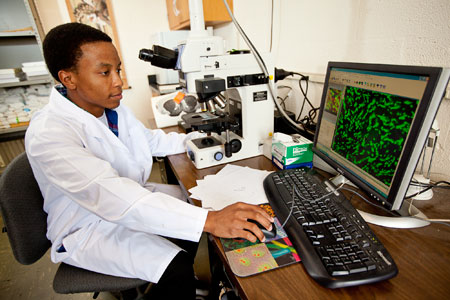At Millsaps College, a private, liberal arts school in Jackson, Mississippi, GSA member Sarah Lea Anglin united with her colleagues Debora Mann, Kristina Stensaas, and Timothy J. Ward to write a proposal for a curriculum development grant. This inter-departmental proposal was successfully funded in 2012.
Finding funding for curricular reforms can be a daunting and frustrating task, but you can significantly enhance the likelihood of success by targeting your efforts and beginning work far ahead of proposal submission time. Until a proposal is funded, it is just that: a proposal. Once funded, it is a grant. To write proposals that become funded grants, we at Millsaps College have found success with the following steps. These are based on the process we used to obtain our most recent Howard Hughes Medical Institute Curriculum Development Grant.
- Developing relationships: Approximately 2 years prior to the proposal due date, the team leader should introduce himself/herself to appropriate officials at the funding agency and begin discussions to determine the goals of that agency for the grant cycle. If those goals fit (or possibly fit) with College goals, proceed; if not, find another funding agency.
- Formation of planning and development team: A working group should be formed that includes representation from all parties that will be involved in the implementation of curricular reforms . This team will work together for the next 1.5 years to plan curricular revisions and write the proposal (and then they’ll work together afterward if the proposal is funded!) It is critical for later buy-in and implementation that all parties be involved in the process; forcing change on individuals or departments without their input is a recipe for disaster!
- Assessment of institutional and funding agency goals: The team should determine which goals of the funding agency will fit with the goals of the team/institution. This is an evolving process that includes identifying the team’s general goals for curricular reform (i.e. identification of strengths and weaknesses in the current curriculum and what types of general reforms are desired) and whether the agency goals can or will fit with these. Again, if the goals don’t fit, find another funding agency.
- Brainstorming a variety of models aimed at improving the curriculum: Team members brainstorm, in large and small groups, various ideas for curricular reform. It is important here to be bold, imaginative, and supportive—do not be constrained by fear of change, and listen to all ideas that are brought to the table.
- Selection of the best curricular reform model: The committee should select the best model that is both desired by the committee and that fits the goals of the funding agency. A brilliant model that only marginally fits the funding agency goals is not the best choice for this agency; neither is a model that fits the agency goals but is not embraced by the committee.
- Plan the curricular reforms: Identify new and existing courses (or revised courses) and experiences (such as undergraduate research), and how they will complement each other to accomplish curricular revision goals. Within this, begin to consider how progress toward those goals will be assessed.
- Identify staffing, laboratory space, and equipment needs to implement the model: Small working groups should develop general ideas for courses (with some specifics, but it is not necessary to develop a syllabus at this time), along with space and equipment needs. This is the time to begin identifying budget items. For sustainability beyond the years of the grant cycle, it is imperative that College administration be consulted and an institutional commitment obtained to sustain supply budgets and maintain equipment.
- Begin the writing process: Pair appropriate team members to write specific portions of the proposal, with instructions to focus on the team and funding agency goals that will be taught and reinforced. Assessment of progress toward goals should be considered at all times; if it cannot be assessed, it isn’t likely to be funded. Once individual parts are complete, work as a team to prepare a full proposal.
- Secure and use an outside reviewer: It is important to identify one informed individual (preferably a scientist), either from another institution or someone from within your institution who was not involved in the writing, to review the proposal. This person should be charged with reading/critiquing/revising the overall proposal for clarity, fit to goals, and singleness of voice. It obviously helps if this person has successful proposal-writing experience. The goal here is to find an informed individual that is not so invested in the writing that he/she cannot see overarching issues with the proposal.
- Submit the proposal in a timely manner: Many signatures will be involved; many persons will need to read the proposal (particularly if matching College funds are required…and if so, it is assumed you’ve already been in consultation with appropriate administrators regarding this!) Do not wait until the day, or even the week, of the proposal due date. Submit it early, verify the submission, and take a break!
The process is long, but the rewards are significant when great ideas become great proposals that become grants. The keys to success are allowing ample time for brainstorming and development of ideas for reform, gaining the support of key faculty at the beginning and involving them throughout the process, and generating a well-written proposal.
Sarah Lea Anglin, Millsaps College Biology Department
Debora Mann, Millsaps College Biology Department
Kristina Stensaas, Millsaps College Chemistry and Biochemistry Department
Timothy J. Ward, Millsaps College Chemistry and Biochemistry Department and Associate Dean of Sciences































